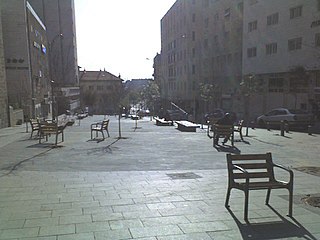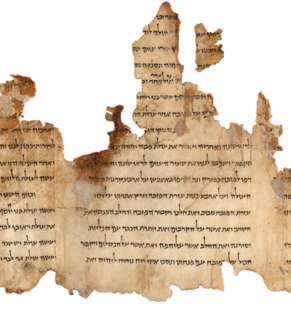Halakha is the collective body of Jewish religious laws derived from the written and Oral Torah. Halakha is based on biblical commandments (mitzvot), subsequent Talmudic and rabbinic law, and the customs and traditions compiled in the many books such as the Shulchan Aruch. Halakha is often translated as "Jewish Law", although a more literal translation might be "the way to behave" or "the way of walking". The word derives from the root that means "to behave". Halakha guides not only religious practices and beliefs, but also numerous aspects of day-to-day life.
The Pharisees were a social movement and a school of thought in the Holy Land during the time of Second Temple Judaism. After the destruction of the Second Temple in 70 CE, Pharisaic beliefs became the foundational, liturgical and ritualistic basis for Rabbinic Judaism.

Shammai was a Jewish scholar of the 1st century, and an important figure in Judaism's core work of rabbinic literature, the Mishnah.

The Sanhedrin were assemblies of either twenty-three or seventy-one rabbis appointed to sit as a tribunal in every city in the ancient Land of Israel.
Tannaim were the rabbinic sages whose views are recorded in the Mishnah, from approximately 10-220 CE. The period of the Tannaim, also referred to as the Mishnaic period, lasted about 210 years. It came after the period of the Zugot ("pairs"), and was immediately followed by the period of the Amoraim ("interpreters").
A beth midrash is a Jewish study hall located in a synagogue, yeshiva, kollel or other building. It is distinct from a synagogue, although many synagogues are also used as batei midrash and vice versa.

Gamaliel the Elder, or Rabban Gamaliel I, was a leading authority in the Sanhedrin in the early first century CE. He was the son of Simeon ben Hillel and grandson of the great Jewish teacher Hillel the Elder. Gamaliel is thought to have died in 52 CE. He fathered Simeon ben Gamliel, who was named for his father, and a daughter, who married a priest named Simon ben Nathanael.
Shemaiah, or Shmaya in Modern Hebrew) was a rabbinic sage in the early pre-Mishnaic era who lived at the same time as Abtalion. They are known as one of the zuggot ("couples"): Shemaiah and Abtalion.
The av beit din, also spelled av beis din or abh beth din and abbreviated ABD, was the second-highest-ranking member of the Sanhedrin during the Second Temple period, and served as an assistant to the Nasi (Prince). The Av Beit Din was known as the "Master of the Court;" he was considered the most learned and important of these seventy members.
The House of Shammai was the school of thought of Judaism founded by Shammai, a Jewish scholar of the 1st century, BCE. A non-literal translation that perhaps gives a better flavour of the expression would be The Academy of Shammai.
Jose ben Halafta or Yose ben Halafta was a tanna of the fourth generation. He is the fifth most frequently mentioned sage in the Mishnah. Of the many Rabbi Yose's in the Talmud, Yose Ben Halafta is the one who is simply referred to as Rabbi Yose.
Eliezer ben Hurcanus, variant spelling, Eliezer ben Hyrcanus, was a kohen, and one of the most prominent Sages (tannaim) of the 1st and 2nd centuries in Judea, disciple of Rabban Yohanan ben Zakkai and colleague of Gamaliel II, whose sister he married, and of Joshua ben Hananiah. He is the sixth most frequently mentioned sage in the Mishnah.
Joshua ben Hananiah, also known as Rabbi Yehoshua, was a leading tanna of the first half-century following the destruction of the Temple. He is the seventh most frequently mentioned sage in the Mishnah.
The Talmudic Academies in Syria Palaestina were yeshivot that served as centers for Jewish scholarship and the development of Jewish law in Syria Palaestina between the destruction of the Second Temple circa 70 CE and the deposition of Raban Gamliel VI circa 425 CE. The academies a great and lasting impact on the development of world Jewry, including the creation of the Jerusalem Talmud. Land of Israel is a religious name for the region which during the Talmudic period was officially known as Syria Palaestina and Palaestina Prima / Palaestina Secunda.

Hillel Street is one of the central streets of Jerusalem. It connects King George Street to the small Ben Sira Street and the Mamilla neighbourhood and is parallel to Ben Yehuda Street. The lower part of the road is between Independence Park and the Nahalat Shiva neighborhood.
Menahem the Essene was a Jewish Tanna sage living during the era of the Zugot. As such, he was "paired" with Hillel the Elder and served as Av Beit Din. The Mishnah, states that he "went forth [out]", and as a result of that he was replaced by Shammai, who became from that point on the "Pair" mate of Hillel the Elder.
Rabbinic Judaism or Rabbinism has been the mainstream form of Judaism since the 6th century, after the codification of the Talmud. Rabbinic Judaism gained predominance within the Jewish diaspora between the 2nd to 6th centuries, with the development of the oral law and the Talmud to control the interpretation of Jewish scripture and to encourage the practice of Judaism in the absence of Temple sacrifice and other practices no longer possible, while waiting for the Third Temple.

Jewish law today prescribes several kinds of hand washing :







